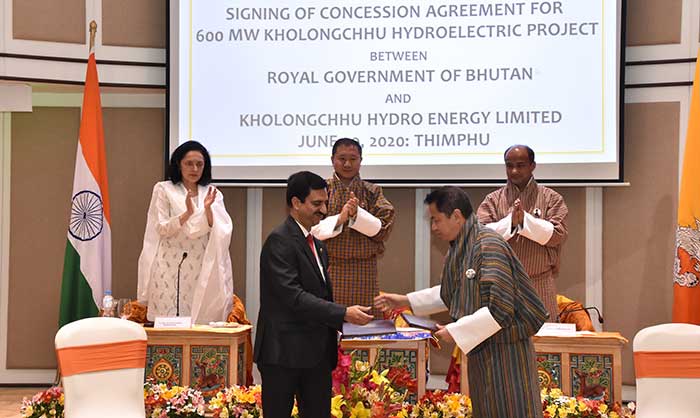MB Subba
The government and the Kholongchhu Hydro Energy Limited (KHEL) signed the first joint venture (JV) hydropower project between Bhutan and India in Thimphu yesterday, six years after the foundation stone was laid.
The Trashiyangtse-based 600MW run-of-the-river project is expected to generate about 2,568.88 million (M) units annually.
KHEL, which is a joint venture company formed between Druk Green Power Corporation (DGPC) and India’s Satluj Jal Vidyut Nigam Limited (SJVNL), is expected to complete the project by the second half of 2025.
The government expects enormous economic opportunities to the community, which is also expected to benefit from the newly-built access roads and bridges.
The joint venture company, which was incorporated on June 12, 2015, is expected to employ about 500 people besides people that contractors would employ, according to the economic affairs ministry.
The other immediate benefits of the project are access roads connecting the gewogs, widening of the national highways near the project, development of integrated township, and the renting of accommodation from the local community at Doksum.
The project is being financed through a debt-equity ratio of 70:30 with 50-50 equity holdings between the DGPC and the SJVNL.
Indian Prime Minister Narendra Modi had laid the foundation stone for the project during his visit to Bhutan on June 16, 2014. His Royal Highness the Gyaltshab Prince Jigme Dorji Wangchuck graced the groundbreaking ceremony on September 18, 2015.
The government says that the pre-construction works have been completed. However, the work award for the construction of the dam, headrace tunnel and the powerhouse have been delayed as the two governments had to finalise tariff determination on a long-term power purchasing agreement (PPA) before signing the agreement.
Speaking at the signing, Foreign Minister Dr Tandi Dorji said the tariff setting formulation was finalised recently and that with the signing of the concessional agreement (CA), the construction of the project was expected to commence anytime soon.
According to the agreement, concession rights are given to the developer to build, own and operate the project for a concession period of 30 years and then transfer it to the Bhutanese government in good running condition at free of cost in keeping with the Bhutan Electricity Act and Bhutan Sustainable Hydropower Development Policy.
The agreement requires the developer to provide maximum local benefits like employment, giving preference to local goods and service providers and, most importantly, the engagement of Bhutanese contractors in the construction of the main components of the project.
The project would have an underground powerhouse of four 150MW turbines with water impounded by a concrete gravity dam of 95 meters height.
Foreign ministers of Bhutan and India emphasised the importance of hydropower development as an important pillar of mutually beneficial bilateral economic cooperation between the two countries.
Lyonpo Dr Tandi Dorji said that the implementation of the project would further strengthen the Indo-Bhutan cooperation in hydropower development. He said that the signing would be an important milestone in the history of hydropower cooperation between Bhutan and India.
“Some may feel that years of delay in the project implementation has led to cost escalation and missed opportunities in terms of immediate benefits to the community. My view is that all the details of the project of such a magnitude should be thoroughly worked out before construction commences,” Dr Tandi Dorji said.
The delay, he said, had benefited in terms of the project being able to undertake confirmatory field investigations to reduce the possibility of unexpected hindrances during the implementation of the project.
“With the signing of the concessional agreement, I have no doubt that the implementation of the main works will commence soon despite numerous challenges caused by the Covid-19 pandemic,” he said.
Lyonpo said the project would have to secure debt financing to immediately start the works and the Indian joint venture partner should take the lead.
“For this, I would like to seek the support and intervention of the Government of India to ensure that the project has access to the most viable financing at the earliest,” he said.
India’s external affairs minister, Dr S Jaishankar, who joined the signing ceremony through video conferencing, highlighted the special ties between the two countries, saying, “the time tested relations, characterised by so much trust and understanding, have matured over the years and have been sustained by the tradition of regular high level visits and dialogues between the two countries”.
He said that hydropower sector was the most visible symbol of the mutually beneficial bilateral cooperation between the two countries. “With continued working together, we are in process of expediting the completion of other ongoing projects including the1200MW Punatsangchhu-1, 1020MW Punatsangchhu-2 and now the 600 MW Kholongchhu HEP.”
He said: “This is yet another milestone in our diverse and multifaceted bilateral cooperation. This has come at a time when our two countries are fighting Covid-19 pandemic. I am sure that the commencement of the construction activities of the Project will create economic and employment opportunities in Bhutan in this critical time.”
And he added: “GoI has provided support, as it should, to Bhutan in terms of medical equipment, kits and medicines as per RGoB’s requirements. Besides continuing with our developmental partnership, we have also ensured uninterrupted supply of essentials and other goods to Bhutan despite the lockdowns.”
Indian ambassador to Bhutan, Ruchira Kamboj, remarked that Kholongchhu project was the continuation of the bilateral cooperation as Chhukha, Tala, Kurichhu, and Mangdechhu projects stood as proud examples, epitomising the core the partnership and friendship for a greater good.
“This project set in the spirituality and culturally rich Trashiyangtse district promises to bring growth and prosperity in the region,” she said.
With the inauguration of the 720MW Mangdechhu Hydroelectric Project in August last year, four hydroelectric projects of bilateral cooperation (336MW Chukha HEP, 60MW Kurichhu HEP, 1020MW Tala HEP, and 720 MW Mangdechhu HEP), totaling over 2,100 MW, are operational in the country today.


